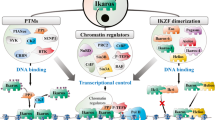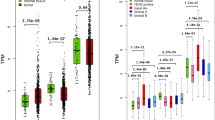Abstract
TFIID, a multisubunit protein comprised of TBP (TATA box-binding protein) and TAFIIs (TBP-associated factors), has a central role in transcription initiation at class II promoters. TAFIIs role as mediators of regulatory transcription factors, such as pRb and p53, and their involvement in signal transduction pathways suggest that some may participate in the control of cell proliferation and differentiation: therefore, they could be considered potential protooncogenes or antioncogenes. With the aim of starting to analyse these potential roles, we have determined the genomic position of nine human TAFII genes (TAFII250, TAFII135, TAFII100, TAFII80, TAFII55, TAFII43, TAFII31, TAFII28, TAFII20/15) and of two previously unknown sequences related to TAFII250 and TAFII31, respectively. Except for those encoding TAFII250 and TAFII31, these genes are present in a single copy and, with the exclusion of those for TAFII43 and TAFII28 (both at 6p21), are localized in different segments of the genome. Indeed, six of them map to a chromosomal region commonly altered in specific neoplasias, which defines them as candidates for involvement in oncogenesis. Our experiments also demonstrate that TAFII transcripts are synthesized ubiquitously, mostly at low levels similar to those of TBP. Interestingly, the amount of the major mRNA species detected by TAFII20/15 cDNA is higher, which suggests that the polypeptide it encodes may also perform functions independently of TFIID. TAFII isoforms, indicated by additional bands on Northern blots, may play a role in modulation of TFIID function. These data will be useful for analysing variations of TAFII mRNA phenotype during cell proliferation, differentiation and development, both normal and pathological.
This is a preview of subscription content, access via your institution
Access options
Subscribe to this journal
Receive 50 print issues and online access
$259.00 per year
only $5.18 per issue
Buy this article
- Purchase on Springer Link
- Instant access to full article PDF
Prices may be subject to local taxes which are calculated during checkout
Similar content being viewed by others
Author information
Authors and Affiliations
Rights and permissions
About this article
Cite this article
Purrello, M., Pietro, C., Viola, A. et al. Genomics and transcription analysis of human TFIID. Oncogene 16, 1633–1638 (1998). https://doi.org/10.1038/sj.onc.1201673
Received:
Revised:
Accepted:
Published:
Issue Date:
DOI: https://doi.org/10.1038/sj.onc.1201673
Keywords
This article is cited by
-
The apoptotic machinery as a biological complex system: analysis of its omics and evolution, identification of candidate genes for fourteen major types of cancer, and experimental validation in CML and neuroblastoma
BMC Medical Genomics (2009)
-
Involvement of GTA protein NC2β in Neuroblastoma pathogenesis suggests that it physiologically participates in the regulation of cell proliferation
Molecular Cancer (2008)
-
A functional interaction between ATF7 and TAF12 that is modulated by TAF4
Oncogene (2005)
-
Genes for human general transcription initiation factors TFIIIB, TFIIIB-associated proteins, TFIIIC2 and PTF/SNAPC: functional and positional candidates for tumour predisposition or inherited genetic diseases?
Oncogene (2001)



